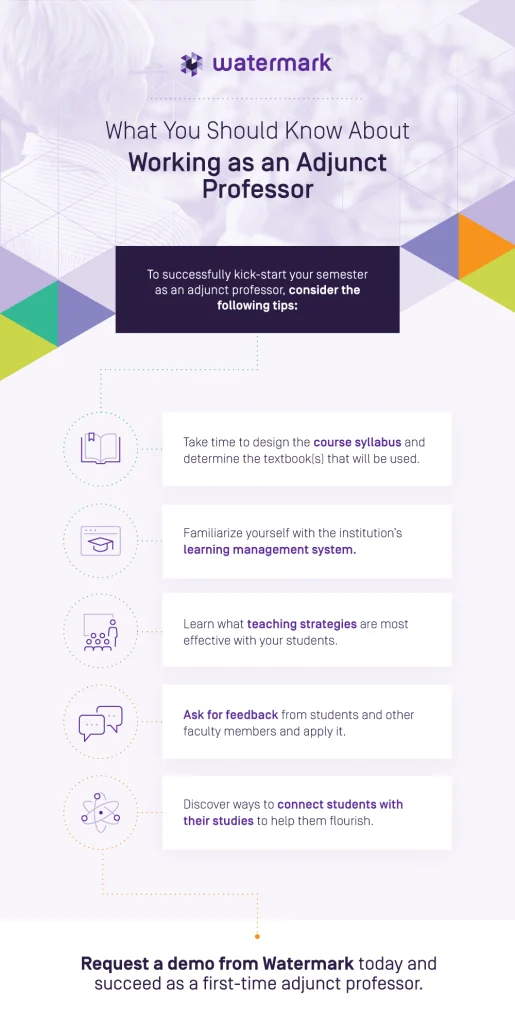



Professionals in higher education have faced challenges in recent years. Budgeting and other institutional changes have brought about shifts in hiring, with fewer full-time faculty and more adjunct and part-time positions. These changes mean professionals within higher education are working for lower salaries and have less job security — however, with these changes come new opportunities.
Many educators are turning to adjunct positions because they can offer flexibility, time to pursue other interests, and fewer responsibilities. (Full-time, tenure-track faculty often have to comply with stringent research and publication requirements in addition to their teaching and advising responsibilities.) With the option to teach on campus, from home, or through a hybrid instruction model, adjunct professors can continue pursuing their interests while leading thoughtful discussions among students.
Transitioning to an adjunct position can be exciting, but you’ll also have to navigate new obstacles and discover how to guide students to the end of the semester while keeping yourself on track and managing your new workload. Thankfully, you can do plenty of things to get ahead of the curve as a first-time adjunct.
Check out these tips for new adjunct professors to ensure you and your students succeed.
Adjunct professors teach at the undergraduate level and higher and typically work contractually and part-time at a higher education institution in a specialized field. They will usually be within a credit hour limit set by the institution. During their time at the college or university, adjunct professors will perform duties such as delivering lectures, assigning coursework, administering assessments, and establishing course materials.
Adjunct professors are typically more flexible than full-time faculty members, prompting higher ed institutions to hire large numbers. However, they work on contract, which means they have reduced job security from semester to semester compared to full-time faculty.
Currently, almost 50% of faculty positions at colleges and universities are part-time. These professors must fulfill the same basic educational requirements as full-time faculty, and many institutions employ adjuncts to keep academic programs or open new ones.
Becoming an adjunct professor might be the right option for you if you are committed to pursuing academic interests while staying on course for your primary career. You can
collaborate with like-minded individuals while shaping the next wave of students.
Before diving in, you should keep a few things in mind. These tips for adjuncts can help you get ahead of your courses and give you ideas for structuring your class, managing learning software, teaching your students, and applying feedback. With these tips, you can kickstart your semester and guide your students to success.

One of the best ways to get ahead of the semester is by planning your course before the class begins. Some of the first obstacles you should overcome are creating the syllabus and determining which textbook will benefit your students.
Your syllabus will outline the flow of the class and provide you and your students with a foundation. Here, you should discuss classroom expectations, such as the grading policy, attendance, participation, and significant dates, such as midterms or finals. Some instructors prefer to create a week-by-week breakdown of course materials and assignments, while others leave the schedule open-ended to accommodate getting ahead or behind on materials.
Choosing a textbook will vary greatly depending on how you intend to instruct the class and the format you choose to implement. Some institutions may have a required text for an adjunct instructor to teach from, especially if you received the position at the last minute. If you are able to choose the textbook, you should research the best editions and authors and read reviews. Additionally, you should consider finding other ways to access textbook materials, such as downloading a PDF version or online books that can cut student costs.
To effectively manage your classroom, you’ll need to understand your institution’s learning management system. These systems serve as central locations to post grades, assignments, course materials, and class documents like the syllabus and course schedule. Examples of these systems include providers such as Blackboard, Desire 2 Learn, and Canvas. You may also need to become familiar with faculty success software, where you can record accomplishments, experiences, and personal information.
Whichever of these support systems your institution uses, you can expect to:
Teaching undergraduates can be exciting, but obtaining a broader understanding of teaching can be beneficial before completely designing your course. Pedagogy — the art of teaching — builds the foundation of undergraduate instruction. You can diversify your pedagogy by varying your instruction methods and reviewing assessment data to determine which teaching strategies and learning activities are most effective with your students.
You should always consider classroom space, course objectives, class size, and student experience when determining how to instruct undergraduates. Remember that lectures are more than showing presentations. You should incorporate visual aids, go beyond the course materials if you recognize student interest or confusion, and develop engaging lectures beforehand rather than solely restating what you know about your field.
Additionally, undergraduate students can benefit from experience outside of class and global perspectives, as they likely have limited knowledge about the area they’re studying, especially if they’re first- or second-year students.

Learning to ask for and accept feedback can be incredibly beneficial for your classroom and professional growth. Everything from faculty reviews to informal advice from a colleague to student course critiques can enlighten you about your strengths and weaknesses as a professor.
Using course evaluation and survey software solutions enables you to create, tailor, distribute, and review course surveys, evaluations, and assessments. Using this software, you can analyze your student’s thoughts and opinions about your instruction methods and whether materials are challenging, interesting, or easily manageable. You can also observe trends over time to determine whether you’re making necessary changes or need to rethink curriculum designs.
Retaining students should be a priority for higher education institutions, as it attests to your institution’s ability to fulfill its promise to deliver quality education to students. To retain students, you need to discover how to engage them and connect them with their studies.
If your institution uses student success or engagement software, you can identify student needs and meet them where they’re at to deliver the education and resources they need to succeed. You can easily schedule meetings and ensure every student stays on track. With early alerts, you can identify at-risk students and connect with them as soon as a problem occurs. You can track trends over time to determine whether you’re reaching your goals and guiding students to success.
Adjuncting is not without its challenges, but it also presents unique opportunities. You can dedicate your time to teaching and, as a free agent, still leverage your experience and skills to find engaging, worthwhile opportunities elsewhere. Let your passions, expertise, and practical needs guide you. With the right tools and a self-starter mindset, you can impact your students and create a custom path toward success.






























































































































































































































































































































































































